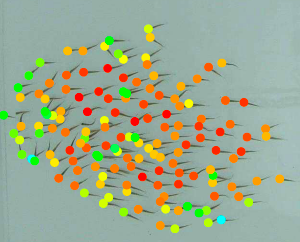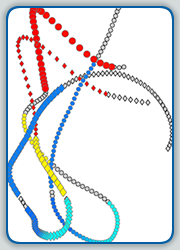One of the fantastic things about studying
collective behaviour is the varying backgrounds of the researchers involved. I
am a great believer that there is no unique way of looking at science. The
more perspectives we have the more chance we have of understanding the essence of a problem. Many of Tuesday's talks at the Interaction networks and collective motion in swarms, flocks and crowds meeting really captured this
diversity. They were focussed on the 'collective motion' problem of describing how fish and birds move in groups.
 |
| Information transfer through a fish school. Work from Iain Couzin's lab |
It started with Iain Couzin presenting his recent work on interaction
networks in fish. His research group have been able to reconstruct the visual
network of schools of fish, understanding who is following who. Iain, who was
one of the leading people in developing the classic self-propelled particle
like models of collective motion, suggested that the best way to understand
information transfer in these groups is through the networks and not
necessarily by building particle models. One of the ideas underlying this approach is to use machine learning to find models that best predict the patterns in the data. The next talk by
Nicolas Perony also advocated this approach. He is going to use multiple sensors to track the details of what meerkats are doing. Machine learning and "reality mining" will be used to understand these vast quantities of collected data.
 |
| Identifying leader follower behavior at the Giuggioli lab |
But there is still place left for 'traditional' approaches of understanding interactions between individuals. Daniel Schardosim Calovi’s talk was on trying to find the interaction rules for Tetra fish. These fish move about in a bursty way, one moving in front followed by another, and capturing these bursts poses new data analysis problems. Maksym Romenskyy was also trying to identify the statistical physics of fish interactions. He showed how this approach might shed new light on attraction/repulsion interactions. Tsuyoshi Mizuguchi and Luca Giuggioli were both concerned with identifying how alignment patterns change between individuals.
I really enjoy seeing all these different approaches in action and it is hard to summarize all the new results in a blog post. But the major thing that struck me was how much more exciting work there is to be done. We have solved a lot of problems in collective motion over the last 5 years, but there are still many new challenges.
No comments:
Post a Comment